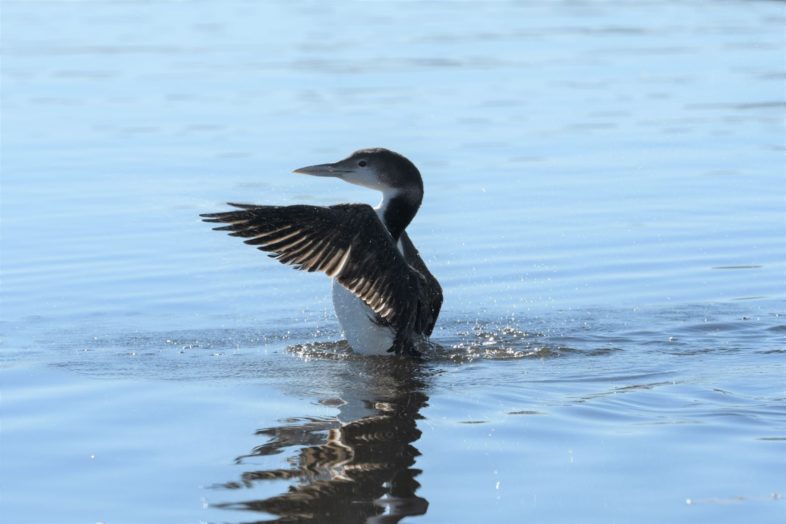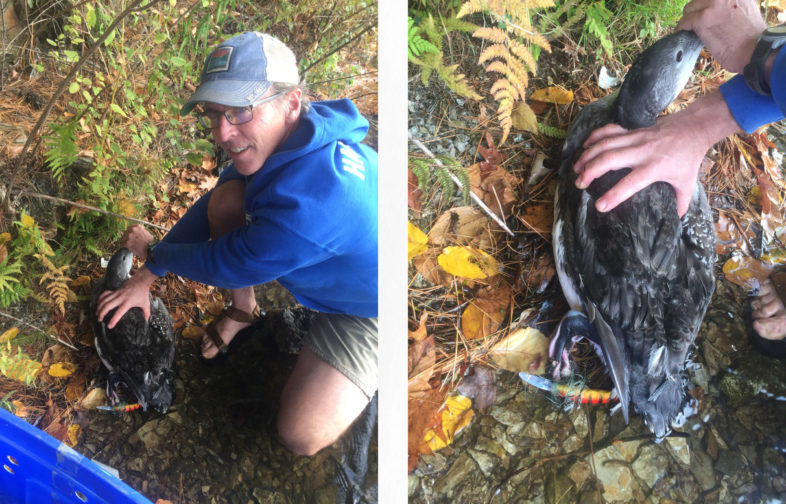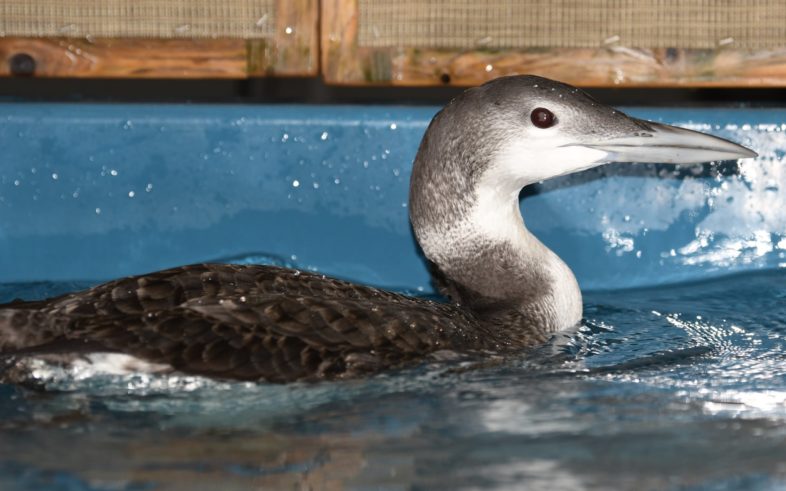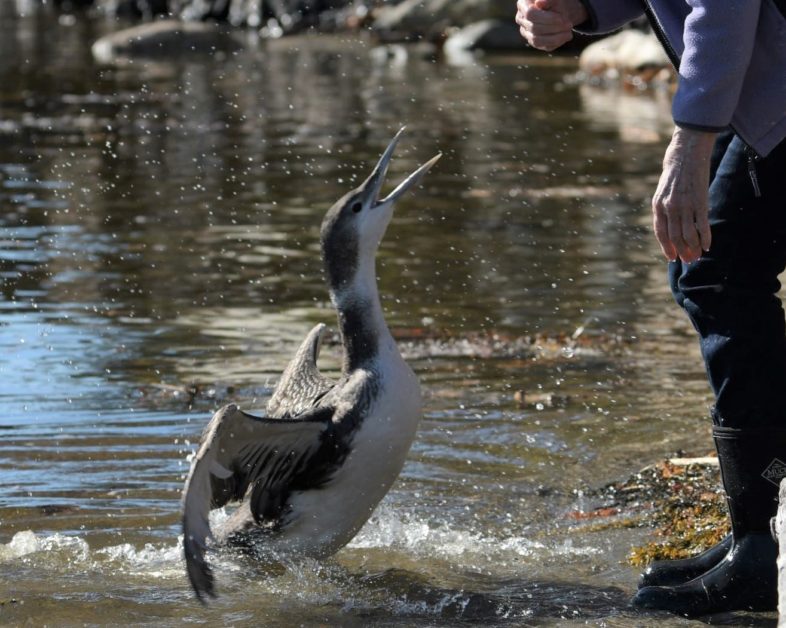
The recovered loon flaps her wings in Penobscot Bay, Maine. © Terry Heitz
By mid-October, I’ve usually switched gears and spend my days on the ski trails at the Craftsbury Outdoor Center, trimming back limbs, building bridges, and thinking snow. However, this year was different. On October 9, I received a call from Laura McCord about a loon trailing milfoil behind it on Lake St. Catherine. Hmm, this was an odd sighting. But two days later Mary Jo Teeter, one of our loon contacts on St. Catherine, provided a troubling update—a lure was spotted near the loon’s feet. This loon was clearly in trouble, and we needed to act fast.
First, Vermont Fish & Wildlife Department game wardens tried catching the free-swimming loon on October 12 but without success. Even injured, she evaded capture with ease. Determined to catch this wounded bird, I prepared my gear for a night attempt and drove down the next day. However, by the time I arrived, Mary Jo found the loon stranded on a nearby beach. Thankfully, this made for a relatively easy catch, but what we found was pretty horrifying—a 4-inch lure, with treble hooks on both ends, had pierced the webbing on both feet. It was a mess.

Finally captured! Now, time to see what we can do about removing that lure. © Mary Jo Teeter
Although fishing gear entanglements are fairly common, it’s quite rare to find a loon with their feet snared. Usually, a loon will get its head and bill caught when pursuing live bait or a lure. We may never know exactly how this individual got tangled, but it’s possible that she could have either snatched the lure from an active angler or encountered it after the line caught on a log or in milfoil
With the loon now safely bundled, I headed to the Vermont Institute of Natural Science’s (VINS) Center for Wild Bird Rehabilitation. They were closed by the time I arrived, but Grae O’Toole, director of the rehabilitation center, had received the message that I was on my way and was ready to examine our patient. The two of us spent almost 30 minutes figuring out how best to remove the five barbs embedded in the loon’s webbed feet. In the end, it was my grandfather’s pliers-wire cutter combo tool that did the trick.
After extracting the lure, Grae began treating the loon with antibiotics due to concerns about necrotic tissue, as well as broken toes. After consulting with Avian Haven in Freedom, Maine, and Dr. Mark Pokras, the leading loon vet in the northeast (retired from Tufts University School of Veterinary Medicine), we decided to proceed with care rather than euthanize her. After all, if she could outswim the wardens’ boat with both feet “tied” behind her back, maybe she could survive on the ocean, even if swimming at 80 percent capacity.
Two days later, I drove the loon to volunteer transporter Dawn Wood in Bridgeton, Maine, who safely delivered her to Diane Winn and her Avian Haven crew. As Diane wrote on Avian Haven’s Facebook page, “it was clear that the loon would lose significant portions of both feet—perhaps as much as half of the left foot, perhaps only a quarter or less of the right. What was not clear was whether a loon could survive in the wild with such significant compromises.” After many email conversations with Dr. Pokras and several loon biologists from Maine and New Hampshire, we decided to proceed with treatment. Diane arranged for foot surgery with Dr. Judy Herman of Animal Wellness Center in Augusta for October 18. We were lucky to have such a knowledgeable surgeon nearby—after all, how many vets do you know with experience performing surgery on webbed feet?

The loon recovers in a pool at Avian Haven post-surgery. © Terry Heitz
The care team at Avian Haven kept the loon dry for two days after surgery before placing her in one of several pools. They changed her bandages daily and provided her with both dry time for healing and water time for eating. Staff noted that she didn’t like being out of the water overnight—a promising sign. By Halloween, the recovering loon was diving just as well as any other loon and staying in the pool full time. By the end of the following week, Dr. Pokras made an on-site visit and thought the webbed tissue had healed over well and the loon was ready for release. We were all relieved by this news—the loon had begun to “pace” back and forth in the pool, a sure sign that she was ready to go.
With a release date in sight, Lucas Savoy, the lead loon biologist of Biodiversity Research Institute, drove up on a weekend (Nov. 6) to place a single US Fish & Wildlife Service silver band on her better leg. The following day, Diane had the privilege of finally releasing the loon in Penobscot Bay. The loon made a quick lunge at Diane upon release before swimming off to open water. Within a surprisingly short amount of time, she grew to be nothing more than a speck on the horizon. Swim safe!

The loon lunges at Diane Winn before swimming away. © Terry Heitz
Thank you to everyone involved in giving this loon a second chance. It was a lot of time and effort (and money) to go to these lengths for one life—but there’s no question in our mind that it was worth it. We all learned a little more about what is possible when a group comes together to help others. A lot of people had a hand in this loon’s spectacular recovery and I’m sure that we all will remember the lessons of compassion taught by this resilient bird.

Great work all and thank you for sharing this inspiring story.
What magnificent work and wonderful outcome. Thank you for all your work.
Great effort by all. Thank you for sharing this story.
Wonderful! Thanks for sharing this very positive, hopeful story…..
Thanks for sharing the details of the rescue and treatment of this lucky loon. Wonderful to know how many individuals contributed to the successful outcome.
Thank you from Lake St. Catherine!
Thank you for all of the effort that was put in to save this beautiful loon. We are lucky to have such dedicated and talented scientists among us.
Yay all of you. Splendid ending, we hope.
Excellent to witness such collaboration between VCE, VINS and BRI. Kudos.
Len